Taxon Attribute Profiles

Cybister tripunctatus
|
Family Dytiscidae
Predaceous Water Beetles
Introduction
Dytiscidae (predaceous water beetles) is one of the largest and most
commonly encountered groups of aquatic beetles. Both adults and larvae
are predaceous, and will attack a wide variety of small aquatic organisms.
Although most species are small to medium sized, some adults can attain
a length of 35 mm.
Taxonomy and Ecology
Synopsis of included taxa
Australia has a rich fauna of Dytiscidae, with 226 species in 42
genera (Gooderham & Tsyrlin, 2002). Watts (1978) supplied a revision
of Australian Dytiscidae; and Pederzani (1995) provided keys to all dytiscid
genera and subgenera for the world. Watts (2002) provided a series of
easy to use keys to the genera of both adult and larval dytiscids. A checklist
of Australian Dytiscidae is available on the Australian Biodiversity Information
Facility website (Lawrence et al., 2002).
General overviews of Australian Dytiscidae, including biological
and ecological information, are provided by Lawrence et al. (1991)
and Gooderham & Tsyrlin (2002).
Life Form
Dytiscids have a characteristic appearance, and can generally be
recognized by having a hard, smooth, oval body, without any ventral spine,
having the hind legs flattened and with a fringe of hairs so that it can
act like a paddle, and having long, thin antennae. In the water, dytiscids
swim by moving their hind legs simultaneously, like oars, while the similar
appearing Hydrophilidae alternate the movement of their hind legs.
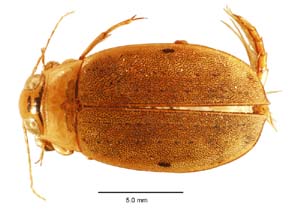
Eretes australis
|
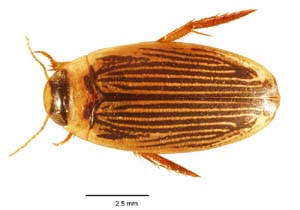
Lancetes lanciolatus
|
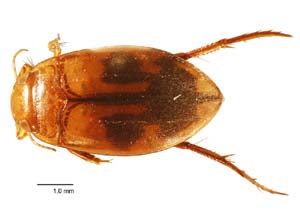
Megaporus howitti
|

Sternopriscus hansardii
|

Click to enlarge map
|
Distribution
Dytiscidae are all aquatic, and are common throughout the continent,
with the greatest number of species found in the south-east. Adults are
capable of flying to isolated habitats, which has allowed their spread
to aquatic habitats throughout Australia.
Habitat
Dytiscids generally prefer slow moving or stagnant water, such as
ponds, lakes, billabongs, dams, and pools at the edges of streams. They
require atmospheric air, and the adult beetles go to the surface to gather
air which they store in a chamber underneath their elytra (wing covers)
to enable them to increase the time they can be submerged. Larvae lack
this ability, but many species use a siphon in the form of long filaments
at the end of the abdomen.
Status in Community
Both adults and larvae are predaceous. The adults are capable of
eating through a normal mouth opening. Most larvae do not have a mouth
opening, but have long, sickle like jaws which enable them to suck fluids
out of their prey items. The larvae will attack animals much larger than
themselves, and have been known to feed on other insects, crustaceans,
worms, leeches, mollusks, tadpoles and small fish.
Reproduction and Establishment
Reproduction
A variety of mating behaviours occur in the Dytiscidae, and many
of them reflect the fact that females are more selective in choosing a
mate than males (Miller, 2003). Males have a variety of methods to achieve
mating, and in some cases females have behaviours to resist mating, such
as swift and erratic swimming when approached by a male. Some males have
even developed sucker-shaped setae on the legs which allow them to grab
females and prevent them from escaping during mating.
Dispersability
Adult dytiscids are capable of sustained flight, and often travel
some distance to disperse and find new habitats. They generally fly in
the evening or at night, and they use reflected light from a water surface
as a method of finding a new habitat. They can be confused by artificial
reflected surfaces (e.g. glass) or lights, and are often attracted to
these sources rather than water.
Juvenile period
Adults generally lay eggs in the underwater stems of plants, using
their ovipositor to cut the stem to deposit the eggs. Dytiscid larvae
are very aggressive predators which attack a variety of prey. Pupation
takes place out of the water. The larva forms a cell in damp soil near
the water, and the adults return to the water after emerging.

Hyderodes sp. larva
|
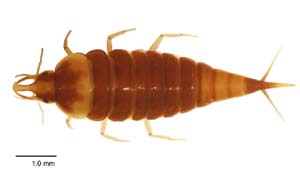
Hyphydrus sp. larva
|
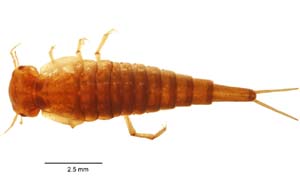
Rhantus sp. larva
|
Hydrology and Salinity
Salinity Tolerance
Gooderham & Tsyrlin (2002) and Chessman (2003) reported that
Dytiscidae as a family are quite tolerant of high levels of salinity.
However, Bailey et al. (2003) list several examples of specific
dytiscids which have very narrow ranges of salinity tolerance and could
be eliminated with minor rises in salinity levels.
Flooding Regimes
Alternating periods of flooding and drought could affect dytiscid populations,
which need water for survival. The strong flying ability of adults will
allow recolonization of aquatic habitats after periods of drought.
Conservation Status
As with most invertebrates, there is insufficient data on Dytiscidae
to discuss conservation status in any intelligent manner. Many species
are known from only a few specimens, but whether this reflects insufficient
collecting or declining population numbers can not even be guessed at.
Uses
There are no records of Aboriginal use of dytiscids as food, although
many insect species were eaten by Aborigines (Tindale, 1966). The large
dytiscid Cybister explanatus is used as food in Mexico, where they
are eaten roasted with salt and in tacos (Ramos-Elorduy & Pino, 1989).
Summary
Dytiscidae share the characteristics of macroinvertebrates that could
make them suitable species for including in programs for monitoring water
quality (Water and Rivers Commission, 1996; Chessman, 2003; Minnesota
Pollution Control Agency, 2004). As of yet, we lack specific examples
of their use in such programs.
List of MDB Species
Table 1. Dytiscidae recorded from the Murray Darling Basin (50 species
in 19 genera).
|
DYTISCIDAE
|
|
Allodessus
|
|
Allodessus bistrigatus (Clark)
|
|
Antiporus
|
|
Antiporus interrogationis (Clark)
|
|
Antiporus balkei (Clark)
|
|
Antiporus femoralis (Boheman)
|
|
Antiporus gilberti (Clark)
|
|
Chostonectes
|
|
Chostonectes gigas (Boheman)
|
|
Chostonectes johnsoni (Clark)
|
|
Chostonectes nebulosus (Macleay)
|
|
Chostonectes sharpi Sharp
|
|
Copelatus
|
|
Copelatus australiae Clark
|
|
Copelatus australis (Clark)
|
|
Copelatus ferrugineus Sharp
|
|
Cybister
|
|
Cybister tripunctatus (Olivier)
|
|
Eretes
|
|
Eretes australis (Erichson)
|
|
Hydaticus
|
|
Hydaticus parallelus Clark
|
|
Hydaticus pulcher Clark
|
|
Hyderodes
|
|
Hyderodes schuckardi Hope
|
|
Hydrovatus
|
|
Hydrovatus armstrongi Watts
|
|
Hydrovatus opacus Sharp
|
|
Hydroglyphus
|
|
Hydroglyphus godeffroyi (Sharp)
|
|
Hyphydrus
|
|
Hyphydrus elegans (Montrouzier)
|
|
Lancetes
|
|
Lancetes lanceolatus (Clark)
|
|
Limbodessus
|
|
Limbodessus amabilis (Clark)
|
|
Limbodessus compactus (Clark)
|
|
Limbodessus gemellus (Clark)
|
|
Limbodessus shuckardii (Clark)
|
|
Limbodessus praelargus (Lea)
|
|
Megaporus
|
|
Megaporus gardeneri Clark)
|
|
Megaporus hamatus (Clark)
|
|
Megaporus howittii (Clark)
|
|
Megaporus wilsoni Mouchamps
|
|
Necterosoma
|
|
Necterosoma dispar (Germar)
|
|
Necterosoma penicillatum (Clark)
|
|
Necterosoma undecimlineatum Babington)
|
|
Necterosoma aphrodite Watts
|
|
Necterosoma susanna Zwick
|
|
Onychohydrus
|
|
Onychohydrus scutellaris (Germar)
|
|
Platynectes
|
|
Platynectes octodecimmaculatus (Macleay)
|
|
Platynectes decempunctatus (Fabricius)
|
|
Platynectes darlingtoni Gueorguiev
|
|
Platynectes reticulosus (Clark)
|
|
Platynectes ocularis (Lea)
|
|
Rhantus
|
|
Rhantus suturalis Macleay
|
|
Sternopriscus
|
|
Sternopriscus alpinus Hendrich & Watts
|
|
Sternopriscus hansardi (Sharp)
|
|
Sternopriscus tarsalis tarsalis Sharp
|
|
Sternopriscus multimaculatus (Clark)
|
|
Sternopriscus meadfootii (Clark)
|
|
Sternopriscus mundanus Watts
|
|
Sternopriscus wehnckei Sharp
|
References
Bailey, P., Boon, P. & Morris, K. (2002) Australian Biodiversity
Salt Sensitivity Database. Land & Water Australia. http://www.rivers.gov.au/research/contaminants/saltsen.htm
Chessman B. (2003) SIGNAL 2 - A Scoring System for Macroinvertebrate
('Water Bugs') in Australian Rivers, Monitoring River Heath Initiative
Technical Report no 31, Commonwealth of Australia, Canberra.
http://www.deh.gov.au/water/rivers/nrhp/signal/
Gooderham, J. & Tsyrlin, E. (2002) The Waterbug Book: a guide to
the freshwater macroinvertebrates of temperate Australia. CSIRO Publishing.
Kefford, B.J., Papas, P.J., Nugegoda, D. (2003) Relative salinity tolerance
of macroinvertebrates from the Barwon River, Victoria, Australia. Marine
and Freshwater Research, 54: 755-765.
Lawrence, J.F. & Britton, E.B. (1991) Coleoptera (Beetles). Pp.
543-683, in Insects of Australia: A textbook for students and research
workers. CSIRO. 2nd Edition.
Lawrence, J.F., Weir, T.A. & Pyke, J.E. (2002) Australian Faunal
Directory: Checklist for Coleoptera: Adephaga: Dytiscidae. Australian
Biological Resources Survey, Department of the Environment and Heritage.
http://www.deh.gov.au/cgi-bin/abrs/abif-fauna/tree.pl?pstrVol=ADEPHAGA&pintMode=1
Miller, K. (2003) The phylogeny of diving beetles (Coleoptera: Dytiscidae)
and the evolution of sexual conflict. Biological Journal of the Linnean
Society, 79: 359-388.
Minnesota Pollution Control Agency (2004). Wetlands: Monitoring Aquatic
Invertebrates. http://www.pca.state.mn.us/water/biomonitoring/bio-wetlands-invert.html
Pederzani, F. (1995) Keys to the identification of the genera and subgenera
of adult Dytiscidae (sensu lato) of the world (Coleoptera Dytiscidae).
Atti della Accademia Roveretana degli Agiati, Serie 7 B, 4: 5-83.
Ramos-Elorduy, J. & Pino M. (1990). Caloric content of some edible
insects of Mexico. Revista de la Sociedad Quimica de Mexico 34(2): 56-68.
Tindale, N.B. (1966) Insects as food for the Australian Aborigines.
Australian Natural History, 15(6), p. 179-183.
Water and Rivers Commission (1996). Macroinvertebrates & Water
Quality. Water Facts 2. http://www.wrc.wa.gov.au/public/waterfacts/2_macro/WF2.pdf
Watts, C.H.S. (1978) A revision of the Australian Dytiscidae (Coleoptera).
Australian Journal of Zoology, Supplementary Series no 57: 1-166.
Watts, C.H.S. (2002) Checklists & Guides to the Identification,
to Genus, of Adult & Larval Australian Water Beetles of the Families
Dytiscidae, Noteridae, Hygrobiidae, Haliplidae, Gyrinidae, Hydraenidae
and the Superfamily Hydrophiloidea (Insecta: Coleoptera). Identification
and Ecology Guide no 43. Cooperative Research Centre for Freshwater
Ecology.
|

